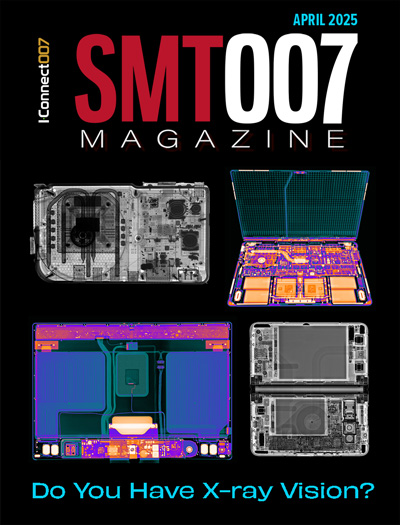-

- News
- Books
Featured Books
- smt007 Magazine
Latest Issues
Current Issue
Moving Forward With Confidence
In this issue, we focus on sales and quoting, workforce training, new IPC leadership in the U.S. and Canada, the effects of tariffs, CFX standards, and much more—all designed to provide perspective as you move through the cloud bank of today's shifting economic market.

Intelligent Test and Inspection
Are you ready to explore the cutting-edge advancements shaping the electronics manufacturing industry? The May 2025 issue of SMT007 Magazine is packed with insights, innovations, and expert perspectives that you won’t want to miss.

Do You Have X-ray Vision?
Has X-ray’s time finally come in electronics manufacturing? Join us in this issue of SMT007 Magazine, where we answer this question and others to bring more efficiency to your bottom line.
- Articles
- Columns
Search Console
- Links
- Media kit
||| MENU - smt007 Magazine
Selecting the Right Potting Compound for Your Application
October 30, 2012 |Estimated reading time: 7 minutes
Editor's Note: This article was originally published in the September 2012 issue of SMT Magazine.Potting materials for electronics and electrical equipment industries cover a device or component to protect it from the surrounding environment. Embedding a device or component in a compound can secure it in the assembly, as well as protect it from moisture, and electrically insulate it so that it will perform as designed.
Potting gets its name from the use of a “pot,” case, or shell that surrounds the device, into which the liquid potting material/compound is introduced. Potting can be performed manually or using automated meter-mix-dispense (MMD) equipment.
Potting Considerations
Selecting the appropriate potting compound for your application prompts the following questions:
- What kind of device/component will be potted? What is the volume of the cavity, or pot, being filled (shot size)?
- Is the device an electronic part, transformer, high-voltage component? Knowing the part characteristics is the first step in selecting the potting compound. While one material might be fine for an electronic part, it may not have the dielectric properties or thermal conductivity necessary for a high-voltage application.
- What will the operating environment be like? Hot? Cold? Will there be exposure to moisture? Solvents or other chemicals? Vibration?
- What is the acceptable curing time or gel time? What is the curing mechanism? UV? Room temperature? Oven?
- What are the adhesive characteristics required by the application? Durable hard bonding? Flexible bonding?
- What is the coefficient of thermal expansion (CTE) of the potting compound? CTE of differences between potting compounds and components may cause stress or even fracturing of fragile component parts.
- Will the potting compound be applied manually or as part of an automated process? How many parts will be made per hour? What is the shot size?
- Will the material need to be flame-retardant?
- What is the desired hardness of the cured compound?
- What is the overall cost? Component parts? Compound? Final product?
These are just a few examples of the considerations to be examined during the potting compound selection process. An experienced materials expert can help to identify the primary concerns, recommend materials, provide testing of the materials, and offer information on dielectric strength, adhesive characteristics, thermal conductivity, and more, through the testing process.
Types of Potting Compounds
There are a variety of potting and encapsulating compounds to consider. The most popular are: epoxy, hot melt, unsaturated polyesters, urethanes and silicones.
Epoxy
The thermal properties of epoxy allow it to work well in applications where it may be exposed to temperatures from 125°C to 155°C. In some cases, there are specially formulated epoxy systems that can be exposed to higher temperatures up to 220°C. Epoxies are very predictable and stable before, during, and after processing. In addition, they offer good chemical resistance with the exception of acids. They provide excellent strength and adhesion, especially to metals and porous surfaces. Moreover, they have a full range of hardened properties depending on the formulation. UV cure versions are available. Figure 1: High-tension starter coils potted with a two-component epoxy system.
Figure 1: High-tension starter coils potted with a two-component epoxy system. Figure 2: Small transformers potted with a two-component epoxy system.
Figure 2: Small transformers potted with a two-component epoxy system.
Standard rigid epoxies are not well-suited for high-impact applications, unless flexibilizers are added to their formulations. Small cracks in a hardened epoxy can become large and easily spread. They are not well suited for PCBs with surface mount technology (SMT) components because they can be too rigid once cured. They do not bond well to flexible plastics and, when bent, the bond can be easily broken. They do not work well with low surface energy (LSE) plastics, as they do not adequately “wet” the plastic.
Hot Melt
Hot melts are easy to use, fast to set, and provide great gap filling. They can be easily removed for repair and rework. They have low heat resistance but good solvent resistance. Hot melts can be polyamide, polyurethane, and polyolefin based. They have a low viscosity when applied at an elevated temperature and they set at room temperature. The polyolefin-based hot melts can be used with LSE plastics that are hard to bond.
Hot melts have a fast average set time of 60 seconds and an unlimited depth of application. They are a cost-effective material
Unsaturated Polyester Resin Unsaturated polyester resins are commonly used in electrical potting applications. The formulas’ mechanical characteristics range from flexible to rigid and can be used in at temperatures up 180°C. Chemical resistance of these materials is fair. Their adhesion to metals is good. Their applied cost is made more economical with the addition of inorganic fillers. The addition of fillers reduces shrinkage during cure.
Urethanes
Urethanes have a broad range of hardness characteristics. With a glass transition temperature (Tg) below -40°C, urethanes are a good choice for PCBs with SMT. Gel times can be easily changed with different formulations to speed up the process. They are suitable for use in applications with operating temperatures up to 130°C. Some specially formulated urethanes can withstand operating temperatures up to 150°C. Chemical resistance is good; however, they cannot be totally immersed in chemicals without failure. They do not work well with low-surface-energy (LSE) plastics, as they do not adequately “wet” the plastic. Figure 3: Example of a two-component polyurethane system offering electronic protection of the circuit board within the housing, which can be found in applications such as automotive electronics, sensors and actuators, or safety devices.
Figure 3: Example of a two-component polyurethane system offering electronic protection of the circuit board within the housing, which can be found in applications such as automotive electronics, sensors and actuators, or safety devices. Figure 4: Examples of two-component epoxy or polyurethane systems used in potting components such as EMC filters, capacitors, power semiconductors or LED displays.
Figure 4: Examples of two-component epoxy or polyurethane systems used in potting components such as EMC filters, capacitors, power semiconductors or LED displays.
Urethanes can be rigid to flexible and cure at room temperature. They are ideal for potting applications that require flexible bonds.
Silicone
Silicone is adaptable to temperatures ranging from -65°C to 200°C. It has a Tg of -40°C, making it a good match for SMT applications. They provide a soft, flexible bond that can be UV cured. Solvent resistance is good, and silicone has a shallow depth of cure and low strength. Adhesion without a primer can sometimes be a problem. High cost is the biggest issue with silicone. It does not work well with LSE plastics, as they do not adequately “wet” the plastic.
UV Curing Materials
Advances in UV curing are allowing design engineers to use different materials for given applications. UV curing materials cure, or harden, when exposed to UV light. The benefits of UV curing include:
- Faster curing: Reducing curing time from hours to minutes or seconds.
- One-component solution: Eliminate two-component handling and mixing waste.
- Longer work times: No time constraints on their use.
UV light sources should be selected for power, spectral output, distance to the substrate, and age of the lamp. High-intensity lamps produce more UV for faster cures, but they also increase heat and are not recommended for heat-sensitive applications.
Applications for Potting Numerous potting applications exist, including:
- Aerospace;
- Automotive;
- Industrial;
- Optical;
- Lighting;
- PCB protection; and
- Electronics.
As design engineers in all of these industries continue to make electronics assemblies that are denser and more powerful, the right selection of potting compounds for the application is more important than ever.
Working with an Experienced Materials Specialist
An experienced materials specialist can help design engineers test the materials for a specific application. This expert can investigate the appropriate potting formulations that will work with the substrate, end-use, and manufacturing process. With an in-house test laboratory, an experienced materials specialist and flexible materials converter, like Fabrico, can look at alternative compounds based on the customer’s specifications.
A materials specialist should offer full integration with the customer’s engineering staff, including 2D and 3D CAD design capabilities, integration of the customer’s electronic drawings, and rapid prototyping capabilities for thorough design vetting before manufacturing.
In addition, the materials specialist should be able to qualify materials and compounds based on in-house laboratory testing for:
- Temperature resistance;
- Performance at upper temperature limits;
- Shear, tensile, and peel strength;
- Outgassing;
- Dielectric strength and electrical conductivity; and
- Thermal conductivity.
For potting compounds, a materials specialist must be able to provide packaging/repackaging to fit the customer’s manufacturing process, including:
- Tubes, cartridges, cans, and bottles;
- Single- and dual-component cartridges;
- Custom blending of fluids, fillers, and solvents;
- Precise pre-mix, pour-measure, and air-free materials;
- Dispensing and curing equipment and supplies; and
- Assembling, kitting, and custom packaging.
In addition, ongoing materials and compounds research will discover new solutions for customer applications in potting and encapsulating.
 Craig McClenachan has held the position of vice president, advanced assembly of Fabrico since May 2009. He was recently given the additional responsibility for developing the company’s Advanced Assembly Business Unit for high-value material and adhesive applications. McClenachan received a Master of Arts in Foreign Policy studies in 1986 from University of Virginia in Charlottesville and a Bachelor of Arts in Government from St. Lawrence University in Canton, New York.
Craig McClenachan has held the position of vice president, advanced assembly of Fabrico since May 2009. He was recently given the additional responsibility for developing the company’s Advanced Assembly Business Unit for high-value material and adhesive applications. McClenachan received a Master of Arts in Foreign Policy studies in 1986 from University of Virginia in Charlottesville and a Bachelor of Arts in Government from St. Lawrence University in Canton, New York.
 Jim Stockhausen has held the position of Business Development Manager for the Electronic and Engineering Materials (E&EM) business line since joining ELANTAS PDG, Inc. in January 2010. His goals in this new position include an aggressive effort to identifying new growth, implementing processes for prioritizing the opportunities, and delivering new sales. Stockhausen has over 20 years of chemical industry experience in business line management and marketing as well as manufacturing and R&D. Stockhausen received his BA in Chemical Engineering from the University of Tennessee and a MBA from Washington University in St. Louis, Missouri.
Jim Stockhausen has held the position of Business Development Manager for the Electronic and Engineering Materials (E&EM) business line since joining ELANTAS PDG, Inc. in January 2010. His goals in this new position include an aggressive effort to identifying new growth, implementing processes for prioritizing the opportunities, and delivering new sales. Stockhausen has over 20 years of chemical industry experience in business line management and marketing as well as manufacturing and R&D. Stockhausen received his BA in Chemical Engineering from the University of Tennessee and a MBA from Washington University in St. Louis, Missouri.


